Popes
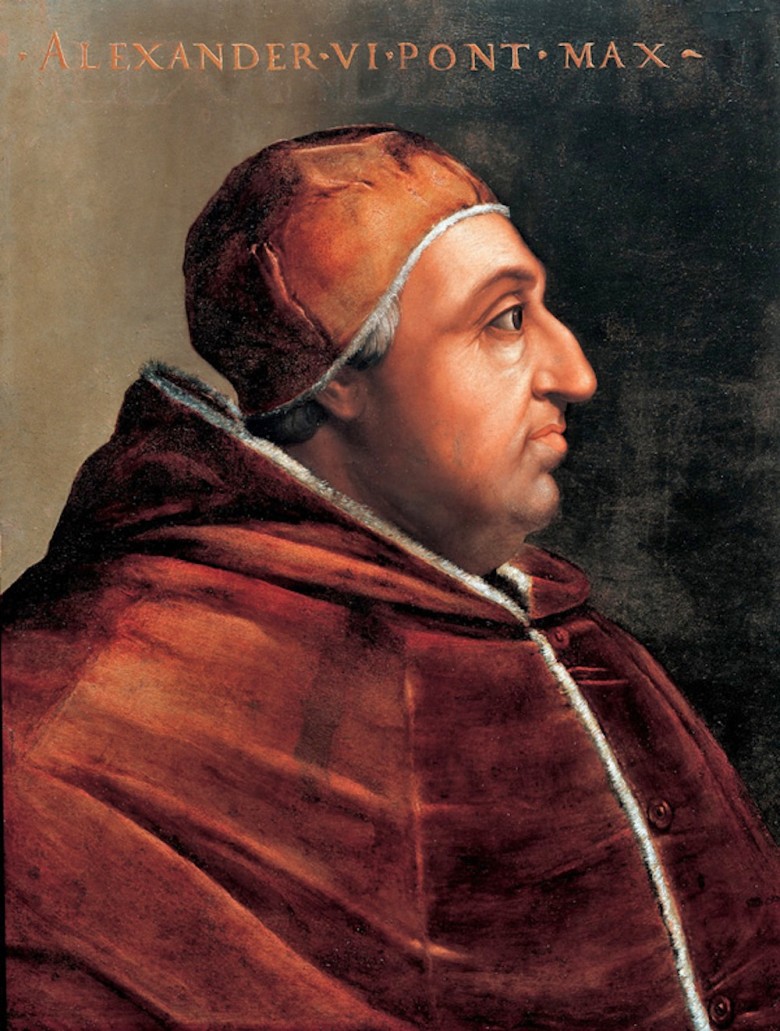 |
| Pope Alexander VI |
(1431-1503)
Pope
1492-1503
Cardinal 1456
Leader of the Papal Army 1457
Vice-Chancellor of the Church 1457.
Son of: Jofre Llancol Escriva & Isabel de Borja y Cavanulles.
Rodrigo Borja's physical traits & personal qualities.
Rodrigo Borja's physical traits & personal qualities.
"Born in 1431 at Xativa, the son of Juana de Borja (sister of Calixtus) and her husband Don Jofrè de Lanzol, Rodrigo was in his twenty-fifth year at the time of his being raised to the purple, and in the following year he was further created Vice-Chancellor of Holy Church with an annual stipend of eight thousand florins. Like his uncle he had studied jurisprudence—at the University of Bologna—and mentally and physically he was extraordinarily endowed. From the pen-portraits left of him by Gasparino of Verona, and Girolamo Porzio, we know him for a tall, handsome man with black eyes and full lips, elegant, courtly, joyous, and choicely eloquent, of such health and vigour and endurance that he was insensible to any fatigue. Giasone Maino of Milan refers to his “elegant appearance, serene brow, royal glance, a countenance that at once expresses generosity and majesty, and the genial and heroic air with which his whole personality is invested.” To a similar description of him Gasparino adds that “all women upon whom he so much as casts his eyes he moves to love him; attracting them as the lodestone attracts iron;” which is, it must be admitted, a most undesirable reputation in a churchman. A modern historian(1) who uses little restraint when writing of Roderigo Borgia says of him that “he was a man of neither much energy nor determined will,” and further that “the firmness and energy wanting to his character were, however, often replaced by the constancy of his evil passions, by which he was almost blinded.” How the constancy of evil passions can replace firmness and energy as factors of worldly success is not readily discernible, particularly if their possessor is blinded by them. The historical worth of the stricture may safely be left to be measured by its logical value. For the rest, to say that Roderigo Borgia was wanting in energy and in will is to say something to which his whole career gives the loud and derisive lie, as will—to some extent at least—be seen in the course of this work." (The Life of Cesare Borgia)
" . . . A contemporary, Sigismondo de' Conti, said of the new Pope: 'Few people understand etiquette so well as he did; he knew how to make most of himself, and took pains to shine in conversation and to be dignified in his manners. In the latter point his majestic stature gave him an advantage. Also he was just at the age (about sixty) at which Aristotle says that men are wisest. Robust i nobody and vigorous in mind, he was admirably well equipped for his new position. He was tall and powerfully built, and, though his eyes were blinking, they were penetrating and lively; in conversation he was extremely affable; he understood money mattes thoroughly.' Another contemporary Hieronymus Portius, described him 1493, says: 'Alexander is tall and neither light nor dark, his eyes are black and his lips somewhat full. His health is robust, and he is able to bear in any pain or fatigue. He is wonderfully eloquent and a thorough man of the world.' (Pope Alexander VI and His Court: xvii)
Description by historian Gasparino of Verona.
A few years later, when Paul II occupied the papal throne, the historian Gasparino of Verona described Cardinal Borgia as follows: 'He is handsome; of a most glad countenance and joyous aspect, gifted with honeyed and choice eloquence. The beautiful women on whom his eyes are cast he lures to love him, and moves them in a wondrous way, more powerfully than the magnet influences iron.'" (Lucretia Borgia @The Project Gutenberg EBook)
By Hieronymus Portius.
"There are such organizations as Gasparino describes; they are men of the physical and moral nature of Casanova and the Regent of Orleans. Rodrigo's beauty was noted by many of his contemporaries even when he was pope. In 1493 Hieronymus Portius described him as follows: "Alexander is tall and neither light nor dark; his eyes are black and his lips somewhat full. His health is robust, and he is able to bear any pain or fatigue; he is wonderfully eloquent and a thorough man of the world.'" (Lucretia Borgia @The Project Gutenberg EBook)
Alexander's trail of mistresses.
" . . . During the 1460s he fathered three children by an unknown mistress (or mistresses), and about 1473 he began a long liaison with Vannozza Catanei, who bore him four children (including Cesare and Lucrezia). . . ." (Skinner & Price: 115)
"Another famous 'papal family' began in 1455 C.E., with the relatives of Pope Calixtus III. This pope appointed his nephew Pope Alexander VI in 1492 C.E. While pope, Alexander had eight illegitimate children by at least three different women, including the infamous offspring Cesare and Lucrezia Borgia. Cesare became Archbishop of Valencia at age 16, he was made a cardinal at 17, and at age 23 he was made the general of the Vatican guard. Unfortunately, Cesare had to murder his own brother in order to acquire the position. Thereafter, Cesare killed his sister's husband, who was a member of the Naples royal family. Lucrezia, who was then without a sexual partner, reportedly had incestuous relations with both her father and her brother." (The Truth: 321)
His lovers were:
Three mistresses who played a prominent role.
"By the historian Gasparino of Verona the young Cardinal is thus described: 'He is handsome; of a most glad countenance and joyous aspect, gifted with honeyed and choice eloquence. The beautiful women on whom his eyes are cast he lures to love him, and moves them in wondrous way, more powerfully than the magnet influences iron.' It appears, however, that only three women played a prominent role in his life. The first was Vanozza dei Catanei, and in his later wife the beautiful Giulia Farnese is mentioned as his mistress. In the intervening period his niece, Hadriana Orsini, seems to have had relations with him, but she patiently effaced herself when any other intimate acquaintance of Alexander was concerned. He never forgot Vanozza, whom he had met in his earlier life; she was born in 1442 and died in 1518, and was the mother of his dearest children. She always lived in magnificence,a nd enjoyed the possession of the various palaces which her lover had given her." (Pope Alexander VI and His Court: xiv)
2) Giulia Farnese (1474-1524)
Lover in 1491-1500.
Daughter of: Pier Luigi Farnese, Signore di Montalto & Giovanna Caetani.
Wife of: Orsino Orsini, son of Adriana de Mila, mar 1489.
 |
| "The one surviving portrait of Giulia Farnese shows her with a unicorn" |
First encounter.
" . . . And it was there, three years later, that Borgia met the beautiful Giulia Farnese---La Bella Giulia---to whom the wits of Rome were to accord the title of 'Christ's Bride.' Giulia came to Adriana's house as her future daughter-in-law. In 1489, when Giulia was perhaps sixteen, she was married in the palace of Rodrigo Borgia to Adriana's only son, and about the same time was added to the lengthy score of Borgia's mistresses." (Chamberlin: 176)
Beneficiaries & patronages.
" . . . The Farnese family, who might possibly have objected to the debauching of a daughter, were easily satisfied from the papal cornucopia. One of Borgia's first acts as pope was to make young Alessandro Farnese, Giulia's brother, a cardinal. The Petticoat Cardinal, the Romans called him, mildly enough, and he bore the title until he too became pope in his turn, as Paul III. Even Giulia's relatives by marriage benefited. Her sister's brother-in-law came in for his share...." (Chamberlin: 175)
Affair's effects on lovers' family, other people and society.
"Around 1483, when Cesare was eight years old and his brother Jofre still a baby, Rodrigo had taken his children away from their mother and placed them in the care of his cousin Adriana da Mila. Despite her evident charms and his affection for her, Vannozza's background made her unsuitable for the upbringing of their family; Adriana, on the other hand, was a Spanish noblewoman and had married into one of the most powerful clans in Rome, the Orsini. In 1489 her son, Orsino Orsini, was married in Rodrigo's palace in Rome to Giulia Farnese, a beautiful nineteen-year-old girl of very modest fortune. Giulia---'la Bella' as she was known throughout Rome---now became Rodrigo's new mistress, while her husband withdrew to his family's country estate at Bassanello." (Hibbert: 31) [Bio1:Historum]
3) Menica.
3) Menica.
Vanozza's mother.
"At the time when he was still practicing law Rodrigo Borgia made the acquaintance of a widow [Menica] and her two daughters. He entered into intimate relations with the mother, and after her death became guardian of the girls. One of these he sent to a convent; the other he made his mistress. This was Vanozza, who is described by contemporaries as a combination of voluptuous beaut, amiability, and shrewdness. He had five children by her, but he did not recognize them openly until after he became Pope. The oldest was Pedro Luis, first Duke of Gandia, who was born about 1467; Giovanni was born in 1474 and assassinated 1498 . . ., and Cesare in 1476. The other two children were Donna Lucrezia, born in 1480 and Don Jofre, born in 141. About 1480 Cardinal Borgia in order to cover up his relations with Vanozza and to lighten his own burden found a husband for her. He obtained a position as apostolic secretary for him from Pope Sixtus IV. This is the only marriage mentioned." (Pope Alexander VI and His Court: vv-xvi)
" . . . About this time he became the lover of a widow who had two daughters. The widow dying, Roderigo took the girls under his protection, put one into a convent, and as the other was one of the loveliest women imaginable, made her his mistress. This was the notorious Rosa Vanozza. . . ." (Dumas: 24)
 |
| Rosa Vannozza de' Catanei |
4) Rosa Vannozza de' Catanei (1442-1518).
Lover in 1470.
Lover in 1470.
"At about this time, 1470, must have begun the relations between Cardinal Roderigo and Giovanna Catanei, or Vannozza Catanei, as she is styled in contemporary documents—Vannozza being a corruption or abbreviation of Giovannozza, an affectionate form of Giovanna.
Wife of:
1. Domenico d'Arignano, Apostolic secretary
2. Antonio de Brescia
3. Giorgio della Croce (d.1486), Apostolic secretary
4. Carlo Canale, mar 1486.
" . . . Rodrigo Borgia arranged for Vannozza Cattanei first to marry Domenico d'Arignano, and then on the death of this first husband, Giorgio della Croce. Both these men were apostolic secretaries at the Vatican Palace. . . ." (The Pope's Daughter: 14)
Giorgio della Croce.
Moreover, had Cardinal Roderigo desired to fasten the paternity of Cesare on another, there was ready to his hand Vannozza’s actual husband, Giorgio della Croce.(2) When exactly this man became her husband is not to be ascertained. All that we know is that he was so in 1480, and that she was living with him in that year in a house in Piazza Pizzo di Merlo (now Piazza Sforza Cesarini) not far from the house on Banchi Vecchi which Cardinal Roderigo, as Vice-Chancellor, had converted into a palace for himself, and a palace so sumptuous as to excite the wonder of that magnificent age. This Giorgio della Croce was a Milanese, under the protection of Cardinal Roderigo, who had obtained for him a post at the Vatican as apostolic secretary. According to some, he married him to Vannozza in order to afford her an official husband and thus cloak his own relations with her. It is an assumption which you will hesitate to accept. If we know our Cardinal Roderigo at all, he was never the man to pursue his pleasures in a hole-and-corner fashion, nor one to bethink him of a cloak for his amusements. Had he but done so, scandalmongers would have had less to fasten upon in their work of playing havoc with his reputation. What is far more likely is that della Croce owed Cardinal Roderigo’s protection and the appointment as apostolic secretary to his own complacency in the matter of his wife’s relations with the splendid prelate. However we look at it, the figure cut in this story by della Croce is not heroic." (The Life of Cesare Borgia)
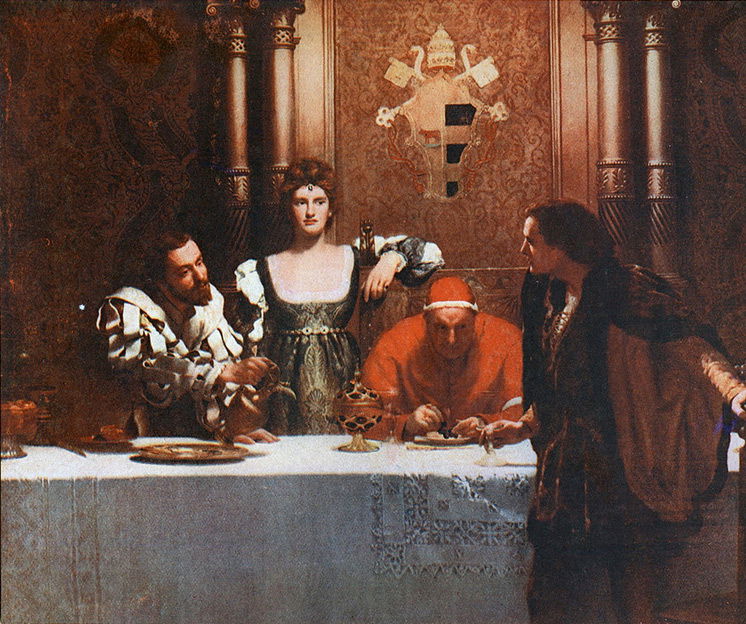 |
| Cesare Borgia, Lucrezia Borgia Alexander VI & a Young Man @ History Today |
Natural offspring:
1. Cesare Borgia.
4. Jofre Borgia.
Vanozza's personal & family background.
"[She] . . . was the daughter of an illustrious family . . . She was born of Roman parents...and was married three times, first to Demenico of Arignano in 1474, second to Giorgio de Croce of Milan in 1480 and third to Carlo Canale of Mantua in 1486. Rosa, whom the Romans call 'la Vannozza' . . . [L]a Vannozza, after her third marriage in 1586, ceased to be the pope's lover. Previous to being Cardinal Rodrigo Borgia's concubine, Vannozza had been the lover of Cardinal Giuliano della Rovere, who became Pope Julius II, and Caesar Borgia may have been their son. In the 1470s Vannozza became the mistress of Cardinal Rodrigo. Depending on Caesar's paternity, she had either three or four children by Borgia --- Caesar in 1475, Juan in 1476, Lucrezia in 1480 and Goffredo in 1481. . . ." (Williams, p. 68)
"About 1466 or 1467 Cardinal Rodrigo's magnetism attracted a woman of Rome, Vannozza Catanei. We know she was born in July 1442, but of her family we are wholly ignorant. Writers of that day also call her Rosa and Catarina, although she named herself, in well authenticated documents, Vannozza Catanei. Paolo Giovio states that Vanotti was her patronymic, and although there was a clan of that name in Rome, he is wrong. Vannozza was probably the nickname for Giovanna--thus we find in the early records of that age: Vannozza di Nardis, Vannozza di Zanobeis, di Pontianis, and others." (Gregorovius, p. 10)
"About 1466 or 1467 Cardinal Rodrigo's magnetism attracted a woman of Rome, Vannozza Catanei. We know she was born in July 1442, but of her family we are wholly ignorant. Writers of that day also call her Rosa and Catarina, although she named herself, in well authenticated documents, Vannozza Catanei. Paolo Giovio states that Vanotti was her patronymic, and although there was a clan of that name in Rome, he is wrong. Vannozza was probably the nickname for Giovanna--thus we find in the early records of that age: Vannozza di Nardis, Vannozza di Zanobeis, di Pontianis, and others." (Gregorovius, p. 10)
"Who she was, or whence she came, are facts that have never been ascertained. She is generally assumed to have been a Roman; but there are no obvious grounds for the assumption, her name, for instance, being common to many parts of Italy. And just as we have no sources of information upon her origin, neither have we any elements from which to paint her portrait. Gregorovius rests the probability that she was beautiful upon the known characteristics and fastidious tastes of the cardinal. Since it is unthinkable that such a man would have been captivated by an ugly woman or would have been held by a stupid one, it is fairly reasonable to conclude that she was beautiful and ready-witted." (The Life of Cesare Borgia)
Siring Lucrezia Borgia while he was the Abbot of Subiaco?.
Siring Lucrezia Borgia while he was the Abbot of Subiaco?.
"Lucrezia Borgia was born, in April 1480, at Subiaco, the first monastery founded by St Benedict, in the mountains east of Rome. Her father, Cardinal Rodrigo Borgia, was chancellor of the Church and abbot of Subiaco. Her mother, Vanessa dei Catanei, was a Roman lady and mother of four of Cardinal Borgia's ten children. . . . " (Pietro Bembo: Lover, Linguis, Cardinal: 416)
" . . . Cardinal Borgia had four others, Giovanni, Cesare, Lucrezia, and Jofre, whose mother's name was Vanozza del Catanei, a Roman. The testimonies that we have of Vanozza speak of her as an excellent woman, and the inscription on her tomb calls her upright, pious, and charitable. Her youngest son Jofre was born in 1480 or 1481; and either immediately before or after his birth she was married to a scribe, Giorgio della Croce, and after his death in 1485, she married a second husband, Carlo Canale, a secretary of the Penitentiary. Vanozza lived a quiet and secluded life; we never hear of her presence at the Vatican or of any recognition shown her by the Pope. She signs a letter to her daughter Lucrezia 'La Felice et Infelice Madre Vanozza Borgia'.'The happy and unhappy mother'. . . ." (Creighton: 187)
" . . . In common with some other high-ranking clerics, Borgia used his exalted position and church wealth to enrich his lover, and Vanozza thus amassed a fortune. She then wisely invested her 'ill-gotten gains' in real estate, inns, and pawnshops. . . ." (Williams and Echols: 87)
Alexander VI's natural offspring.
"But worse still was the reputation of Alexander's children, and Burchard's blithe comment that they were 'utterly depraved' barely begins to cover the crimes with which they were associated in the contemporary imagination. Lucrezia (1480-1519) -- with whom the pope was reputed to have slept -- was cast not only as a whore, but also as a poisoner, a murderer, and a witch. And Cesare (1475/6-1507) -- the most handsome, dashing, and despicable Borgia of all -- was widely believed to have killed his elder brother Juan in a fit of jealousy, bedded his sister, and embarked on a campaign of slaughter and conquest aimed at carving a kingdom out of the scattered states of Northern Italy." (History Today)
"In this same year 1460 was born to Cardinal Roderigo a son—Don Pedro Luis de Borja—by a spinster (mulier soluta) unnamed. This son was publicly acknowledged and cared for by the cardinal. Seven years later—in 1467—he became the father of a daughter—Girolama de Borja—by a spinster, whose name again does not transpire. Like Pedro Luis she too was openly acknowledged by Cardinal Roderigo. It was widely believed that this child’s mother was Madonna Giovanna de’ Catanei, who soon became quite openly the cardinal’s mistress, and was maintained by him in such state as might have become a maîtresse en titre. But, as we shall see later, the fact of that maternity of Girolama is doubtful in the extreme. It was never established, and it is difficult to understand why not if it were the fact." (The Life of Cesare Borgia)
Pope Anastasius.
His lover was:
Theodora.
" . . . After Marozia's lover Pope Sergius III died her mother Theodora quickly maneuvered one of her lovers into position to become Pope. This was Pope Anastasius III 911-913 AD. . . ." (The Roman Catholic Church: The Cold Hard Facts: 64)
Pope Benedict VI.
Pope 973-974.
"Benedict VI was the illegitimate son of a monk. During his papacy, many European ladies who came to Rome were seduced or raped there, and remained as courtesans.Benedict was seen as the source of this decadence, and was dragged to the Castel Sant'Angelo for 'his wickedness', and strangled." (A Corrupt Tree: An Encyclopaedia of Crimes Committed by the Church of Rome: 168)
 |
| Pope Benedict IX |
the Demon from Hell in the Disguise of a Priest (by St. Peter Damian).
Son of: Alberic III of Tusculum.
 |
| Pope Benedict IX @ Hutton Archive/Getty Image |
"Benedict was bisexual, sodomised animals and prescribed murders. He hosted extravagant homosexual orgies in the Lateran Palace which he turned into the 'best brothel in Rome'." (The Corrupt Tree: 169)
Pope Benedict XII.
"Pope Benedict XII (1334-1342) tried to bribe Petrarch, the scholar and poet, with a cardinal's hat in order to sleep with his sister. Benedict was successful after bribing Petrarch's brother, Gerardo." (Dogma Evolution & Papal Fallacies: 266)
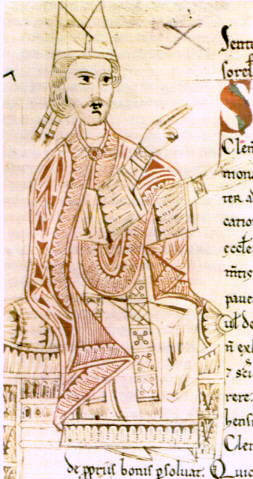 |
| Pope Gregory VII |
Pope Gregory VII (1015/28-1091)
Also known as:
Greatest of All Popes: " . . . For the first great pope, Gregory VII, who has often been called the greatest of all popes, was himself a Cluniac. . . ." (Bozeman: 255)
His lover was:
Pope Hormisdas.
Pope 514-523.
" . . .Pope Sylverius *536-537 AD) was fathered by Pope Hormisdas (514-523). . . ." (The Roman Catholic Church: The Cold Hard Facts: 27)
"Pope Leo XII (1823–1829), as a young prelate was suspected of having had a liaison with the wife of the soldier of Swiss Guard and as nuncio in Germany allegedly fathered three illegitimate children." (Wikipedia)
(1417-1471)
Pietro Barbo
Also known as:
Our Lady of Pity (It. Maria Pietissima)
"Paul had quite a sex life, not just for a pope, but for anybody. Paul has been accused of preserving a certain unsavory papal 'tradition.' Allegedly, for several centuries, popes maintained a convent full of sex slaves who were particularly adept in staging satanic sexual orgies as well as producing babies for sacrifice. Although this is not really supported by documentation and sounds like the kind of stuff that would be whispered in the medieval alleyway, we all know what can happen with 'evidence' especially when the powerful want to get their mitts on it. But there is apparently substantial written material attesting that Paul liked to keep the company of attractive young men while shunning women. Easily moved to tears at the sight of his favorite boys, Paul’s cardinals referred to him as 'Our Lady of Pity'. Paul supposedly died of heart attack while being sodomized by a boy lover." (Willdorf, 2011)
"First up is Pope Paul II. Pietro Barbo was born in Venice on February 23, 1471 to a rich merchant family. His uncle was Pope Eugene IV and by 47, he too became pope. He liked to call himself Pope Formosus, from the Latin meaning, 'beautiful, handsome'. However, as you can see from his profile, he was anything but. It took some persuasion but he finally settled for Paul. (Willdorf, 2011)
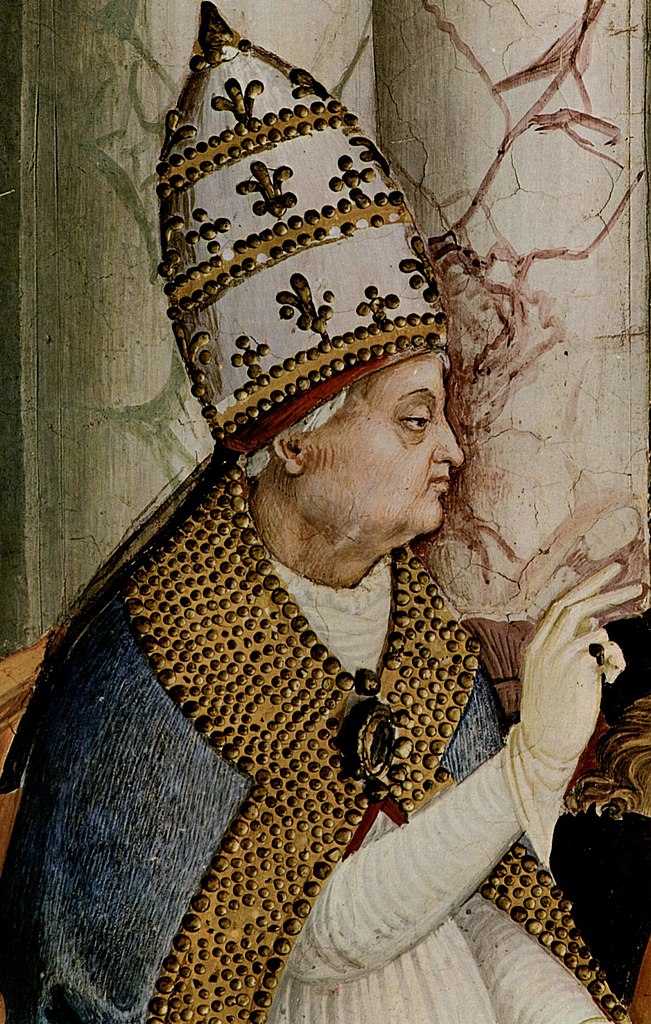 |
| Pope Pius II 1502-1507 |
(1405-1464)
Enea Silvio Bartolomeo Piccolomini
Pope
1458.
Bishop of Siena
Bishop of Trieste
Imperial poet laureate 1442
Son of: Silvio Piccolomini & Vittoria Fortequerri.
"Pope Pius II (1458–1464) had at least two illegitimate children, one in Strasbourg and one in Scotland, both born before he entered the clergy. Pius delayed becoming a cleric because of the requirement of chastity." (Wikipedia)
Son of: Silvio Piccolomini & Vittoria Fortequerri.
"Pope Pius II (1458–1464) had at least two illegitimate children, one in Strasbourg and one in Scotland, both born before he entered the clergy. Pius delayed becoming a cleric because of the requirement of chastity." (Wikipedia)
His lover was:
1) Elizabeth.
a Breton woman
Natural offspring:
Natural offspring:
A child who survived 14 months.
Cardinals.
 |
| Cardinal Beaton @Wikipedia |
(1494-1546)
Cardinal
Archbishop of St. Andrews
Chancellor of Scotland
His lover was:
Marion Ogilvy (c1500-1575)
Lover in c1520
Daughter of: James Ogilvy, 1st Lord Ogilvy of Airlie & Janet Lyle
Wife of: William Douglas (d.1547), mar 1547
Natural offspring:
a. David Betoun of Melgund
b. Alexander Betoun, Archdene of Lothian
First encounter: " . . . Marion's mother died soon after 1520 and it was left to Marion to manage the estate. At about this time she met David Beaton, then the Abbot of Arbroath Abbey, and the two formed a close relationship. So close, in fact, that she lived with him at Ethie Castle and became the mother of his eight children. . . ." (Undiscovered Scotland)
" . . . His favourite mistress was Marion Ogilvy, daughter of Sir James Ogilvy, who was created Lord Ogilvy of Airlie in 1491, and died in 1504. At a very early period in his career, he seems to have lived in concubinage with this woman; and he certainly heaped upon her wealth and property, if he degraded her by his illicit amours and the refusal of the honourable bond of marriage. . . ." (The Martyrs of Angus and Mearns: Sketches in the History of the Scottish Reformation: 279)
" . . . It is certain that Beaton did not himself attempt to realize the system of a celibate clergy. He had a flourishing family of sons and a daughter. Family, in this case, had been generally used in the plural number. The historians speak of him as a voluptuary; even Tytler, a writer with no bias against him, mentions the Cardinal's gallantry and licentiousness as a matter of notoriety... What is assuredly known of Beaton's gallantries is that he had one mistress, Marion Ogilvy, daughter of Sir James Ogilvy, who was created Lord Ogilvy of Airlie. . . ." (Hay: 80)
Cardinal Beaton's character/persona: "More particularly, Beaton was a profligate prelate. 'It must be acknowledged,' says MacKenzie, 'that he was a man of unlimited ambition, endued with good natural parts, and well seen in all the parts of literature, but of a very irregular life, being much addicted to the pleasures of the fair sex, even after his advancement to the priesthood. . . ." (Scott: 279)
Using her "natural-beauty" investment well.
"Women who used their natural beauty to advance their careers included elite and royal mistresses. A good example is Marion Ogilvy, daughter of Lord Ogilvy of Airlie, mistress of Cardinal Beaton, and an astute financier who accumulated a large property portfolio. David Beaton treated her as a wife in all but name for two decades and they had eight children. Had he lived after the Reformation they could have married, but as he rose through the ranks of the church he was able to compensate Marion with more grants of property. Like any wealthy mother she tried to marry her daughters into good families and succeeded in getting the master of Crawford to marry her daughter Margaret. After the assassination of the cardinal in 1546 Marion was briefly married to William Douglas. His death in 1547 left her in charge of her own affairs once more and she robustly defended the interests of her family until her death in 1575." (The Scottish People 1490-1625: 109)
Natural Offspring: "Prelatical writers, anxious to screen Beaton, have asserted that he was married, and the father of several children, before he entered into priest's orders; but there is not a particle of legal evidence to support this statement. Indeed, in all the documents where Beaton's children are mentioned they are distinctly described as natural. Chambers, in his Picture of Scotland (Vol. II., pl. 234) says: 'He is well known to have had six illegitimate daughters, besides sons, almost all by different mothers. . . It would appear that the Cardinal . . . concerned himself very little about the concealment of these breaches of decorum, since 1545 he passed to Finhaven, and there, in a style of the most ostentatious magnificence, married one of his daughters to the Master of Crawford.' The Editor of Keith's History (Vol. 1., p. 113) sates 'that three of the Cardinals' sons were legitimated, according to the Scottish law, during his lifetime. These were James, Alexander, and John Beaton, and in the Act of Legitimation they are styled natural sons of the right Reverend, etc.' Alexander became Archdene of Lothian, and at the Reformation joined the Protestant Church." (Scott: 107)
Benefits: "After Cardinal Beaton acquired the barony of Melgund, in 1542, he built the castle there, and resided in it with Marion Ogilvy, daughter of the first Lord Airlie, his mistress, and the mother of his children. . . The Cardinal settled the property on his mistress in liferent, and on his eldest son, David, in fee. Marion Ogilvy often resided there. It is now believed that the Cardinal and she were united by a sort of morganic (sic) marriage, not unusual among churchmen at that loose period, and letters of legitimation of two, at least, of his sons are entered in the Great Seal Register. In 1552 Robert Carnegie of Kinnaird was named one of the procurators by Marion Ogilvy of Melgund (Lady Melgund) for resigning the lands of Abdene, Kethyness, in the barony of Rescobie, for a re-grant to her natural sons, David and John Beatoun. =David succeed his father, the Cardinal, in Melgund, and he married E. Menzies. Their son James Betoun, 'fier of Melgund,' in 1589 granted a bond of manrent to the Earl of Huntly, whereby he was to serve him when required, except when he was doing his duty to the King, or to the Earl of Crawford." (Angus Or Forfarshire: The Land and People, Descriptive and Historical, Vol 2: 318)
" . . . In 1524 Beaton granted her part of his estate of Arbroath Abbey and Marion was subsequently more than capable of defending her landholdings in court when challenged. In 1543 Beaton, by now a Cardinal and Chancellor of Scotland, endowed on Marion the estate of Melgund Castle in Angus which he had rebuilt as a family home. The redevelopment including the insertion over the doorway of their joint coats of arms: a recognition of the fact that they had been married in all but name for some 20 years. . . ." (Undiscovered Scotland)
Cardinal Cornaro
Governor of Rome.
His lover was:
Anna Cicciaporci.
: "Cardinal Cornaro, Governor of Rome, of noble birth, but poor, weak, and dissipated, paid his court to the handsome Anna Ciciaporci, a member of a once famous family, now extinct, whose palace then stood in the Banchi, near the church of S. Celso. It is at present used as a restaurant. The Cardinal had a son by this lady, called Antonio, and his intimacy with her was so open and well known that she commonly went by the nickname of the Abbe Anna, as though she had been her lover's secretary." (Silvagni, 1885, p. 107)
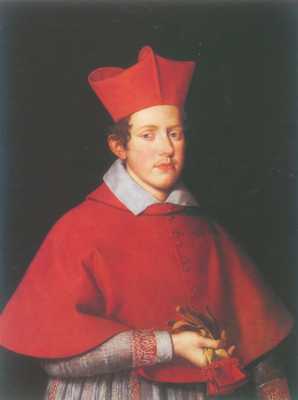 |
| Ferdinando I di Gonzaga Duca di Mantova e Monferrato |
(1587-1626)
Cardinal
[Ref1:5]
His lover was:
Camilla Faa di Bruno.
 |
| Cardinal de Bernis Detail of a print, engraving by Domenico Cunego, after a painting by Antoine-Francois Callet by Antoine-Francois Callet |
Francois de Bernis (1715-1794)
a.k.a.
Francois-Joachim de Pierre de Bernis
Abbe de Bernis
Cardinal de Bernis
Protector of the Church of France (by Pope Pius VI)
la Belle Babet (by Voltaire)
Babet the Flowergirl.
French cardinal & statesman
French ambassador to Venice 1753-1756
His lovers were:
1) Marina Morosini.
(the "MM" in Casanova's diary).
2) Princess Santacroce
2) Princess Santacroce
"Among the many fine ladies who frequented Pope Pius's Court, none was more admired and sought after than the Princess Santacroce, whose name has already been frequently mentioned. Her connection with Cardinal de Bernis was well known, but the gay lady liked a variety in her gallants, and the Cardinal was followed in her favour by the Spanish Ambassador, Count Florida Blanca, and his successor, Azara. It is more than hinted by Count Verri, Abbe Benedeti, Casanova, and other writers, that the Pope himself worshiped at the shrine of this fail but frail princess. Certain it is that she was in high favour at Court, and that she dispensed honours and emoluments far and wide." (Rome, Its Princes, Priests and People, Volume 2: 106-107)
Physical Traits & Personal Qualities: (He was)..."a plump, pink-cheeked little abbe about town, known more for his pretty verses than his religious convictions...." (Algrant, 2003, p. 39). [Bio1:Catholic Encyclopedia] [Bio2:Cardinals of the Holy Roman Church] [Bio3: La Croix] [Ref1]
Innocenzo Cardinal Cibo.
His lover was:
Louis I de Lorraine-Guise.
(1527-1578)
1st Cardinal de Guise
Archbishop of Troyes 1543
Archbishop of Albi 1550
Archbishop of Sens 1560-1562
Bishop of Metz 1568
Abbott of Saint-Victor
Abbott of Moissac
Abbott of Saint-Pierre de Bourgueil.
His lover was:
Unnamed mistress.
Natural offspring:
a. Anne d'Arne (d.1549)
Maid of Honour to Elisabeth de Valois.
Wife of: Johann von Janowitz (1537-1577) mar 1572/74.
Louis-Rene-Edouard de Rohan-Guemene
Cardinal de Rohan.
His lover was:
Marie-Francoise-Julie-Constance Filleul (1751-1822)
a.k.a. Madame de Menars.
Wife of: Abel Poisson, Marquis de Marigny, marr 1767.
"Marigny's marriage failed in the mid-1770s. Julie embarrassed Marigny by flagrantly becoming the mistress of the young cardinal de Rohan. Marigny offered a generous separation agreement . . . if she would agree to retire to an apartment within the grounds of the convent. She refused, at which point a legal separation was drawn up that nullified most of her claims to his houses or assets except what was specifically settled upon her or what she had been previously granted. They were legally separated on 23 September 1777. Marigny maintained a dignified gravitas in dealing with her, formally offering her the right to use the title of marquise de Menars when he was granted that dignity in 1778. She accepted with equally chilly formality." (The Houses and Collections of the Marquis de Marigny: 13)
Personal & Family Background: Marie-Francoise was the natural daughter of the financier Bouret. " . . . There is a strong probability that Marie Francoise Julie Constance Filleul was the child of Michel Bouret, wealthy fermier general, who had a long affair with Irene Du Buisson. . . . " (The Houses and Collections of the Marquis de Marigny: 12)
Luigi Cardinal de Aragon.
(1474-1519)
a.k.a.
Luigi Cardinal d'Aragona
Luis, Cardinal de Aragon, Marchese di Geraco.
Son of:
Arrigo d'Aragona
& Polissena de Centellas
Natural grandson:
Ferrante, King of Naples
Natural brother:
Alfonso I, King of Sicily.
Husband of:
Battistina Cibo Usodimare
Granddaughter of:
Pope Innocent VIII.
married, in 1492.
His lover was:
Giulia Campana.
Thomas Wolsey.
Cardinal
His lover was:
Joan Larke (d.c1529).
[Ref1]
Cardinal Zelada.
"The Cardinals, as a body, followed the Pope's lead. Cardinal Zelada, who was afterwards Secretary of State, a cultivated, astute, dissolute, and elderly man, courted the Princess Giustiniani, whose former lover, a young and handsome prelate named Ferretti, surprised the Princess and Cardinal in most affectionate conversation together at the Castle of Bassano. Ferretti, who had run after the Princess for eight years, consoled himself for his dismissal by the smiles of the Princess Gabrielli di Presede; but here again, the unfortunate lover was superseded by another cardinal---Giovanni Battista Rezzonico, a small, ill-shapen man of great natural tact and sagacity, who must not, however, be confounded with his brother, the Cardinal Camerlingo. Rezzonico was Secretary of Petitions, and had great influence, which he dispensed, especially among the ladies, with no niggard hand. He had already had a favourite before the Princess Gabrielli, in the youthful Raccatini, but he disposed of her by finding her a husband, whose fortunes he made his peculiar care." (Rome, Its Princes, Priests and People, Volume 2: 107)
Archbishops & Bishops.
Aelfwine of Winchester
Archbishops & Bishops.
Aelfwine of Winchester
(d.1047)
a.k.a. Aelfwine of Winchester.
His alleged lover was:
Emma de Normandie, Queen of England (985-1052)
". . . . As a secular bishop in a monastic cathedral he was unpopular, and this was probably a factor in a famous legend that he was Emma's lover. She was said to have disproved this charge by walking barefoot unharmed over burning ploughshares." (Wikipedia)
(1440-1522)
1st Marquez de Valencia.
a.k.a. Alfonso of Portugal.
His lover was:
Filippa de Macedo
(1460-?)
Son of:
Affonso de Portugal
4th Conde de Ourem
& 1st Marques de Valencia
(1403-1460)
& Brites de Sousa.
Daughter of:
Joao Gonzalves de Macedo
1st Senhor de Melgaco
& Isabel Gomes Rebelo.
Natural offspring:
[Gen1]
1) Francisco de Paula de Portugal
(1480-1549)
1st Conde de Vimioso
(legitimized in 1505)
2) Martinho de Portugal
(d.1547)
Archbishop of Funchal
3) Beatriz
(d.1530)
"Like an earlier royal ambassador, Dom Pedro de Noronha, who headed Joao's obedience embassy to Innocent VIII, this Dom Martinho of Portugal was a bastard son of a bishop. It should perhaps be noted that the father, a layman at the time of Martinho's birth, was the illegitimate son of the Count of Ourem who headed the Portuguese embassy to Pope Eugenius IV and to the Council of Basel in 1436. King Joao III had previously sent Martinho to Rome, and on July 12, 1527, Pope Clement VII named Martinho his legate a latere to Portugal and granted him an imposing list of privileges. Martinho returned to Rome in 1532, and there maintained a brilliant establishment and temporarily enjoyed the favor of the Holy Father. . . In general, this Martinho was hardly a savory character. His contemporary the Venetian Leonardo de Ca' Masser links his name with the wealth confiscated in Portugal from Jews." (The Quest for Eastern Christians: Travels and Rumor in thje Age of Discovery: 152)
Pompous prince?: "Cardinal Albrecht of Brandenburg (1490-1545) had studied in Frankfurt an der Oder and in Italy, and became archbishop of Mainz at the age of only 24. A renaissance prince on German soil, he strove to imitate the pompous courts of the Roman clergy. He had mistresses, for whom he provided generously, and kept three residences, which he decorated with splendid works of art. His life style was so costly that even the indulgences, which he introduced in Germany, were not able to fill his forever empty purse." (The Temptation of Paul Hindemith: Mathis Der Maler as a Spiritual Testimony: 31)
References:
Abbot of Inchaffray
Abbot of Scone
Bishop of Moray 1527
Son of:
Margaret Stewart
married
1) Patrick Graham, 1st of Inchbraikie
2) Sir Colin Campbell, 6th of Glenorchy
(d.1583)
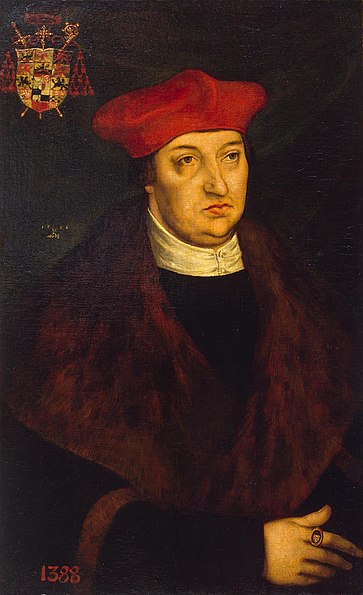 |
| Albrecht von Brandenburg Elector-Archbishop of Mainz |
(1490-1545)
Elector-Archbishop of Mainz
Archbishop of Magdeburg
a.k.a.
Albrecht von Mainz
Albrecht von Hohenzollern.
His lovers were:
1) Magdalena Redinger
"...He had a mistress, a baker’s daughter called Magdalena Redinger. The image of a woman above the Cardinal’s head like a sword of Damocles may refer to the Cardinal’s mistress." (Dewil)
"Another painting of Lucas Cranach showed the baker’s daughter Magdalena Redinger who was the mistress of the Cardinal. Cranach showed her as Mary Magdalene, a close theme since the Cardinal’s mistress’ name was also Magdalene. Lucas Cranach showed how rich Magdalena could be dressed. She is on her way to virtue, on the path that leads away from sin, but she still wears all the jewels the Cardinal must have given her around her neck....." (Dewil)
2) Ulrich von Hutten. (1488-1523)
German scholar, poet & reformer
" . . . Thanks to his poetic gifts and the friendship of Eitelwolf von Stein (d.1515), he won the favour of the elector of Mainz, Archbishop Albert of Brandenburg. . . ." (Wikipedia)
" . . . The young bishop was somewhat worldly-minded, extravagant, better trained in humanistic studies than in theology, too much given to the patronage of learned men and artists. His long intimacy with Ulrich von Hutten is especially reprehensible. . . ." (Catholic Encyclopedia)
Pompous prince?: "Cardinal Albrecht of Brandenburg (1490-1545) had studied in Frankfurt an der Oder and in Italy, and became archbishop of Mainz at the age of only 24. A renaissance prince on German soil, he strove to imitate the pompous courts of the Roman clergy. He had mistresses, for whom he provided generously, and kept three residences, which he decorated with splendid works of art. His life style was so costly that even the indulgences, which he introduced in Germany, were not able to fill his forever empty purse." (The Temptation of Paul Hindemith: Mathis Der Maler as a Spiritual Testimony: 31)
Albrecht the exception: "The mistresses of princes differed from the concubines of non princely nobles in being drawn primarily from the nobility. According to Paul-Joachim Heinig, German ecclesiastical princes in the late fifteenth and sixteenth centuries usually practiced monogamous relationships with women from the higher nobility---that is, women who might have been acceptable marriage partners if the men had been eligible to contact a legal marriage. Very few came from the lower nobility, though at least a quarter of the concubines were non-nobles, probably burghers. An exception to this pattern was the most famous ecclesiastical prince of the era, Cardinal Albrecht von Brandenburg, archbishop of Mainz. Albrecht had five known mistresses, some of whom he is said to have had depicted in the guise of. . . ." (Noble Strategies: Marriage and Sexuality in the Zimmern Chronicle: 206)
Mistresses in Men's Clothing?: " . . . Albert's financial needs and his association with his employment of the Dominican friar were not conducive to conveying the impression of religious respectability. John Tetzel's dramatic and exaggerated preaching of the indulgences left a scandalous impression, but so did Albert's luxury loving and sensual life as he traveled about with his mistresses piquantly clad in male costume. . . ." (fofweb)
References:
(1478-1537)
a.k.a. Alexander Stewart of Pitcairn.
Prior of WhithernAbbot of Inchaffray
Abbot of Scone
Bishop of Moray 1527
Son of:
Alexander, Duke of Albany
& Catherine Sinclair
daughter of William, Earl of Orkney and Caithness.
A Scottish Parliament in 1516 declared Alexander Stewart to be illegitimate, long after his parent.
His lover was:
Unknown mistress.
Natural offspring:Margaret Stewart
married
1) Patrick Graham, 1st of Inchbraikie
2) Sir Colin Campbell, 6th of Glenorchy
(d.1583)
(1470-1520)
Illegitimate son of: Fernando II de Aragon & Aldonza Ruiz de Iborre y Alemany.
His lover was:
Ana de Gurrea y de Gurrea (1470-1527)
Daughter of: Juan de Gurrea & Catalina Lopez de Gurrea.
Natural offspring:
b. Juana de la Cavalleria
f. Juana de Aragón y de Gurrea (c1495-?)
g. Juan de Borja, 3rd Duque de Gandia
h. Ana de Aragón y de Gurrea (1502-?)
i. Alonso de Guzmán, 5th Duque de Medina Sidonia
j. Juan Alonso de Guzman, 6th Duque de Medina Sidonia
k. Antonio de Aragón Señor de Quinto
(1533-1589)
Hungarian nobleman, bishop, humanist & diplomat.
Bishop of TinaAmbassador to Poland.
Andrija Dudic Orehovicki
Andras Dudith de Horahovicza.
His lover was:
Sophia Genesilla.
 |
| Andreas von Osterreich Unknown artist, 16th century @ Die Bischofe von Konstanz |
(1558-1600)
Margrave of Burgau
Governor-General of the Netherlands, 1598-1599
Cardinal 1574
Bishop of Constance 1589
Prince-Bishop of Brixen 1589
Administrator of Deren
Abbot of Murbach 1587-1600.
Son of:
Ferdinand II von Osterreich
& Philippine Welser.
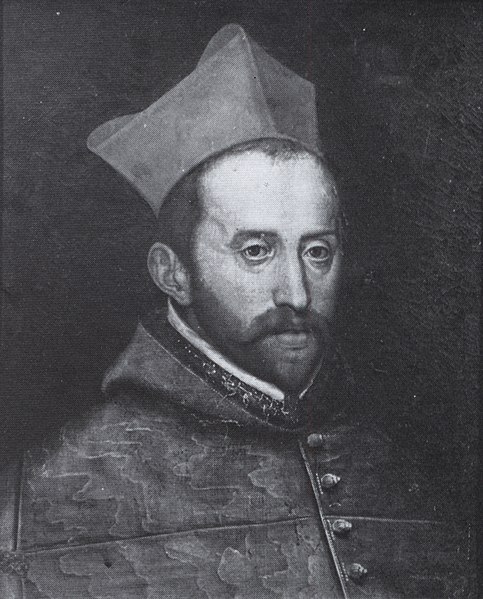 |
| Andreas von Osterreich by Anonymous, 16th century @ Ambras Castle |
His lover was:
Unnamed mistress.
Natural offspring:
1. Hans-Georg degli Albizzi
(1583-?)
2. Susanna degli Albizzi
(1584-1653)
"The elder son, Andreas of Austria (1558-1600), was made a cardinal in 1576 and was promised a bishopric to ensure an income for him -- without his having taken holy orders. He eventually received the richly endowed benefices of the prince-bishoprics of Constance (1589) and Brixen/Bressanone (1591), where he is commemorated bu the magnificent bishops' palace. The cardinal's activities, however, took place in the diplomatic rather than the pastoral sphere. His undiplomatic and at times ruthless actions make his legacy as governor of various Habsburg territories controversial. He fathered two illegitimate children, a son and a daughter. Andreas died during a visit to Rime, where he is buried." (The World of the Habsburgs)
(1713-1788)
French theologian
a.k.a. Antoine de Montazet.
His lover was:
Louse d'Aumont, Princesse de Monaco
Archbishop Sheldon.
His lover was:
His lover was:
Annette d'Armagnac.
(1434-1488)
Canon of Lyon, 1443
Archbishop of Lyon, 1444
Papal Legate at Avignon, 1472-1476
Administrator of Diocese of Clermont, 1476
Cardinal, 1476
Commendatory Abbot of
Priory of Notre-Dame de La Charite-sur-Loire, 1486
Duc de Bourbon & d'Auvergne, 1488
French royal diplomat
"Charles II de Bourbon was a wealthy and important French courtier, a confidant of King Louis XI, to whom he was related by marriage. He held among other posts, the governorship of Paris. Grandson of the Burgundian duke John the Fearless and cousin to Charles the Bold, he also bore numerous connections with the Southern Netherlands, making various visits to both Bruges and Brussels. The burgher like figure right of Joseph may be Charles de Bourbon himself, as some have suggested. However, the head bears very little resemblance to the painted portrait of the cardinal now in Munich. His contemporary the French court chronicler Philippe de Commynes remarked that Cardinal de Bourbon was 'not born for the peaceful functions of the priesthood. . .he had taste only for the tumult of arms. He used the unbishoply motto: n'espoir ne peur.' Indeed this 'unbishoply' declaration of 'No hope, no fear'has been repeated eleven times in the tapestry border." (Tapestry in the Renaissance: Art and Magnificence: 80-81)
 |
| Charles II de Bourbon Stained glass @ Moulins Cathedral |
His lover was:
Gabrielle Bartine.
Natural offspring:
Isabelle de Bourbon
(d.1497)
married
Gilbert de Chantelot
Sire de La Chaise.
 |
| Charles-Joseph de Lorraine Prince-Elector of Osnabruck |
Charles-Joseph de Lorraine (1680-1715)
a.k.a.
nee Charles-Joseph-Jean-Antoine Ignace Felix de Lorraine.
Charles III of Lorraine.
Bishop of Olomouc 1695-1711
Prince-Bishop of Osnabruck 1698-1715
Archbishop of Trier 1711-1715
Prince-Elector of Trier 1711-1715.
His lover was:
Karl-Josef retained Osnabruck until 1714 while intriguing constantly for other benefices. Never advancing beyond sub-deacon, he once contemplated marrying an Italian countess and had an affair in 1709 with the wife of the captain of his brother's Swiss guards. But with his older brother pulling the strings and providing most of the bribes, they set their sights instead on the highest rungs of Germania Sacra. After a few costly but futile campaigns, they succeeded in having Karl-Josef elected Coadjutor of the Archbishop-Elector (Kurfurst) of Trier in 1710. The successful candidate was wheeling and dealing furiously, paying the Emperor 25,000 gulden from a Jewish banker in Frankfurt against his Osnabruck revenues. When the dust settled in 1710, even with only sixteen votes for sale, the brothers had spent over 775,000 livres tournois to obtain the position generating at most 270,000 livres. Karl-Josef officially became Kurfurst von Trier in 1711. It was the highest ecclesiastical position ever obtained by the house of Lorraine, and was celebrated by three days of fireworks at Nancy. Unfortunately, he died only four years later." (A Bewitched Duchy: Lorraine and Its Dukes, 1477-1736: 153)
(1754-1838)
Abbott of Saint-Denis de Reims 1775
Bishop of Autun 1788-1791
President of the Assembly 1790
Ambassador to London 1792
Prince of Benevento 1806
Son of: Charles-Daniel de Talleyrand-Perigord & Alexandrine Damas d'Antigny.
Husband of: Catherine Worlee, a.k.a. Madame Grand, married 1802.
His lover was:
1) Adelaide de Flahaut (1761-1836)
a.k.a.
Adelaide Filleul
Adelaide de Souza-Flahaut.
Wife of:
1. Comte Flahaut de La Billarderie (1726-1792), mar 1792,
2. Baron de Souza
Portuguese Ambassador
mar 1802.
Lover in 1783-1792.
"... Madame de Flahaut's other lover was Charles Maurice de Talleyrand-Perigord, then a Catholic bishop. Her husband was a political cipher, but her clerical lover was razor-sharp, destined for great things, and Madame de Flahaut and Morris kibitzied his career from the sidelines...." (Brookhiser, 2009, p. 148)
2) Dorothe Luzy (1747-1830)
French comedienne 1757
a.k.a.
Dorothe Dotinville
Dorothe Dorinville.
Wife of:
1. Francois Guillon, mar bef. 1793, div 1794
2. Jean-Gerard Maris.
3) Julienne Picot.
Lover in 1770.
Daughter of: French restaurant owner.
4) Marguerite-Josephine Weimer (1787-1835)
French stage actress.
a.k.a.
Mademoiselle George
Mademoiselle Georges
Marguerite Georges
Marguerite-Josephine George
Marguerite-Josephine Weimer George.
Lover in c1804.
References for Prince de Talleyrand.
Memoirs of the Prince de Talleyrand @ archive.org
Charles-Maurice Le Tellier
Archbishop of Reims.
His lover was:
Anne-Charlotte d'Aumont (1665-1724)
Marquise de Crequy
a.k.a. Anne-Charlotte de Crequy.
Daughter of: Louis-Marie-Victor d'Aumont, Duc d'Aumont & Madeleine Fare Le Tellier.
Wife of: Francois-Joseph de Crequy de Blanchefort (1662-1702), mar 1683.
Lover in ????
Her other lover was:
Abbe d'Estrees.
" . . . Consider the case of the marquise Anne-Charlotte de Crequy, who was not only the niece of Archbishop Le Tellier of Reims but also his lover. 'Until his death she loved him more than an uncle.' Later she became the mistress of the abbe d'Estrees, and when this second ecclesiastical lover died in 1718, the marquise was' widowed' for the third time, her lawfully wedded husband having died in 1702. . . . " (Saint-Simon & the Court of Lois XIV: 212) [Fam1]
Dominique de Vic
Archbishop of Auch.
His lover was:
Charlotte des Essarts (1580-1651).
Comtesse de Romorantin.
Countess of Romorantin
Duchess of Vitry.
a.k.a. Ferdinand-Maximilien-Meriadec de Rohan.
His lover was:
 |
| Charlotte Stuart, Duchess of Albany by Hugh Douglas Hamilton Scottish National Portrait Gallery |
Charlotte Stuart, Duchess of Albany (1753-1789)
Prince Charles Edward Stuart
Fernando de Aragon (1498-1577)
Archbishop of Zaragoza
His lover was:
Maria Jimenez Cerdan.
Francois de Chaligny (1599-1672)
Bishop of Verdun 1623
Son of: Henri de Lorraine (1570-1600), Comte de Chaligny & Marquis de Moy & Claude de Moy (1572-1627)
Husband of: Christine de Massauve (d.1675)
His lover was:
Sabine-Marie Broons
Natural offspring:
1. Francoise-Marie
Legitimee
2. Louise-Michelle
Legitimee.
Dom Garcia de Meneses
Bishop of Evora.
His lover was:
Margarita Tinoco
"It was in the well at the foot of this tower that the Bishop of Evora, Dom Garcia de Meneses, died. Of poison, if we are to believe Rui de Pina. Since Dom Joao II could not do to the Bishop, who was plotting against him, what he ad done to the Duke of Viseu, that is kill him with his own hands, poison would have been an effective and discreet way of getting rid of the person who was the ringleader of the plot. This happened some five hundred years ago, in 1484...." (Saramago, et. al., 2002, p. 350)
 |
| Gebhard Truchsess Archbishop of Cologne |
Gebhard Truchsess
Archbishop of Cologne
His lover was:
Agnes von Mansfeld, a nun;
"But the list of Catholic prelates who turned Protestants for the sake of a woman and her love is not yet exhausted. Thus, Gebhard Truchsess, Archbishop of Cologne in the sixteenth century, fell in love with a beautiful nun, Agnes de Mansfeld. The Archbishop, who had every facility to see and speak to the religieuse, availed himself of this opportunity to disclose his love to the woman who had left the world. He conjured her to return to the life of love and she readily consented. For some time the Archbishop kept his mistress in the episcopal palace of Broel, beyond the Rhine, near Cologne, and afterwards in the castle of Koisuverd. At last, however, the prelate grew tied of the continual secrecy he was compelled to observe. He turned Protestant and openly married his mistress." (Rappoport, 2003, p. 46)
Heraclius (1128-1191)
Patriarch of Jerusalem
Bishop of Caesarea
[Bio1]
His lovers were:
1) Agnes de Courtenay, Empress of Constantinople
2) Paschia de Riveri.
Henry Beaufort
Bishop of Lincoln & Winchester
Daughter of:
Richard FitzAlan, 10th Earl of Arundel
& Elizabeth de Bohun.
Richard FitzAlan, 10th Earl of Arundel
& Elizabeth de Bohun.
Wife of:
His lover was:
Alice de Percy
(1150-1180)
Natural offspring:
1. Hugh Le Puiset, Chancellor of France
2, William Le Puiset, Archdeacon of Northumberland
| James Stanley Bishop of Ely |
James Stanley
Bishop of Ely.
(1471-1514)
His lover was:
Margaret NN.
[Bio1:Tudor Place]
[Fam1:Tudor Place]
(d.1579)
Bishop of Condom, Valence and Die.
Jean de Bourgogne, Bishop of Cambrai.
His lover was:
(1734-1821)
His lover was:
Marie-Jeanne Becu de Cantigny, Comtesse du Barry
John Hamilton
(1512-1571)
Scottish prelate & politician
Abbot of Paisley (1541)Keeper of the Privy Seal (1543-1546)
Treasurer of the Kingdom (1543-1554)
Bishop of Dunkeld (1543)
[Bio2:Electric Scotland]
Natural son of:
James, 1st Earl of Arran.
His lover was:
Grisel Sempill
Natural offspring:
1. Margaret Hamilton
2, John Hamilton, of Blair
3. William Hamilton, of Drumry and Torry
Joao Manoel de Vilhena
Bishop of Ceuta.
Physical Traits & Personal Qualities: "...He lived life to the full. Handsome, intelligent, witty, he was an attractive figure, fond of clothes, food, drink and sex. His attempted seduction and failed rape of his wife's niece Theodora in 1114 has become notorious because his intended victim later became the well-known hermit, Christina of Maryate...." (Tyerman, 1996, p. 58)
Anne de Beauvilliers, Abbesse de la Joye (1652-?).
Daughter of: Francois de Beauvilliers, Comte de Saint-Aignan & Antoinette Servien.
". . . She became involved in a romantic liaison with Henri Joseph, Marquis de Segur (1661-1737), a decade her junior. This association led to the incorrect assumption that Anne de Beauvilliers was the 'Portuguese Nun' of the famous letters." (A Bit of History)
"The Abbess of Maubuisson, Louise Hollandine, the daughter of Frederic V, Elector-Palatine, of the days of Henri IV, had had so many illegitimate children, that she commonly swore by her body, which had borne fourteen children." (Memoirs of Louis XIV and the Regency: 380)
"Louise continued to a late age to occupy herself with painting, and adorned her own and many neighbouring churches, with sacred pictures. She died at the age of eighty-eight. Calumny sticks fast, and even yet adheres to her name, partly from the prejudice of Protestant writers of the last century against nuns, partly from a misunderstood passage in one of the letters of her niece the Duchess of Orleans, quoted by Madame Blaze de Bury in justification of her unfounded assertion that Elizabeth never had any sympathy or intercourse with her sister. This was to the effect that she used to swear 'by the fourteen children she had borne!' and glorified in her shame. Apart from the fact that history knows nothing of the existence of any such children, it is glaringly out of harmony with all Liselotte's other affectionate mentions of her aunt. If genuine, it probably refers to her predecessor, about whom there really had been scandal; if actually spoken of Louise, the reference may have been to jesting words of old bygone reports when they had ceased to rankle, in the questionable taste of that day in which both the Abbess of Maubuisson and her niece were too prone to indulge. As a matter of serious testimony by Monseigneur Bossuet and others who had known her well, she had the credit of having restored the discipline of her convent, which before her day had grown extremely lax." (A Sister of Prince Rupert, Princess Palatine and Abbess of Herford: 281-282 )
"Take Casanova's mysterious 'MM,' for example, who historians now agree was almost certainly Marina Morisini. Born into a patrician family, she wound up, like so many women of her time, an unwilling nun at the notorious Venetian convent of Santa Maria degli Angeli. As Summers points out, residency at a nunnery had more to do with grim socioeconomic reality than with any religious vocation. “Being forced to become a nun was a common fate of the unmarried daughters of Venice’s noble families, not least because the dowry required to become a bride of Christ was far less than that required to secure a good husband.” Bridling to find herself held in this de facto prison, the 22-year-old set out to seduce Casanova after spotting him in the convent’s chapel. (He was already romancing two other nuns.) Through a variety of maneuvers that would qualify her for membership in any spy agency, MM was able to get word to Casanova that she wanted him as a lover. (She was already sleeping with François de Bernis, the French ambassador to Venice.) Before long, they were making love in the secret apartment de Bernis kept for her, complete with “a pretty box filled with hand-made condoms” and a peephole so the voyeuristic Frenchman could watch her and Casanova make love." (Salon)
(d.1476/88)
Bishop of Ceuta, 1443
Primate of Africa, 1444
Bishop of Guarda, 1459-1476.
"One possibility is suggested by a passing anecdote told by the Portuguese genealogist Antonio Caetano de Sousa, who records how Frei Joao Manuel, Bishop of Gurda and illegitimate son of the scholar-king Duarte, took as his mistress a Flemish lady of the Portuguese court called Justa Rodrigues Pereira, who bore him two illegitimate children...." (Macpherson and MacKay, 1998, p. 100)
Josef Wilhelm von Hohenzollern-Hechingen
Josef Wilhelm von Hohenzollern-Hechingen
Prince-Bishop of Ermland.
(1178-1836).
His lover was:
Demoiselle Bode aus Danzig.
Natural offspring:
Carl Friedrich Wilhelm, Freiherr von Woehstein.
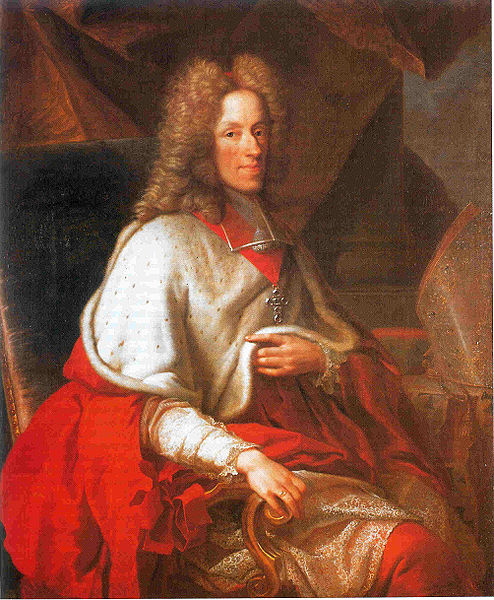 |
| Joseph Klemens von Bayern Archbishop-Elector of Cologne |
(1671-1723)
[Pix1]
His lovers were:
1) Anna-Francoise de Louchier.
2) Constance de Grousselier.
Karl von Osterreich (1590-1624)
Bishop of Breslau
Bishop of Brixen.
Son of: Karl von Osterreich & Maria Anna von Bayern.
Catalina Isabel de Torres de Navarra y Baylen (1585-1616)
Daughter of: Gaspar de Torres de Navarra & Juana Martinez de Baylen
Wife of:
Johann Anton von Thun-Castel Thun (d.1602), mar 1601
Natural offspring:
Louis de Bourbon, Prince-Bishop of Ghent
(1438-1482)
Her lover was:
Katharina von Egmont, Regent of Geldern.
a.k.a. Katherina van Egmond.
Louis Annet de Clermont de Clermont de Chaste de Roussillon, Bishop of Laon (d.1721)
Louis Annet de Clermont de Clermont de Chaste de Roussillon, Bishop of Laon (d.1721)
His lover was:
Marie-Emilie de Joly de Choin (1664-1732)
"....She entered into a relationship with Louis, le Grand dauphin, in parallel to having a relationship with the Count of Clerment-Chaste. It was rumoured that Marie Émilie and Clerment-Chaste planned to conquer the throne by producing a child from Louis through her. When these plans were discovered, Marie Émilie and Clerment were both exiled from court (1694). The relationship to Louis did not end, however..." (Wikipedia)
Catherine-Henriette Bellier, Baronne de Beauvais (1614-1689)
a.k.a. La Beauvais, La Borgnesse (by Anne of Austria).
Lady of the bedchamber of Anne of Austria.
Daughter of: Martin Bellier.
Wife of: Pierre, Baron de Beauvais.
Her lovers were:
Louis XIV de France
Lover in 1653.
Archbishop of Sens:
"Madame de Beauvais served at the court as chief lady-in-waiting to Anne of Austria, the wife of Louis XIII. She later became the first mistress of the young Louis XIV, thirty years her junior. She was the mother of Andre de la Betoulout (1629 – 1693), Seigneur de Frementau and Comte de La Vauguyon who was married the wealthy older widow Marie de Stuer de Caussade de Saint-Maigrin (c1611 – 1693), Comtesse de Broutay. Madame de Beauvais always retained the affection and regard of King Louis and was mentioned in the Memoires of the court historian the Duc de Saint-Simon." (Russell)
"Anquetil tells us that his Majesty next paid his addresses to La Brauvais, the first lady in waiting to the queen, 'a woman of experience,' and nicknamed by Anne of Austria La Borgnesse. She was dismissed the service, but was soon afterwards reinstated, her Majesty being unable to get on without her. This matter would hardly deserve remar, but for the fact of St. Simon having seen her at the toilette of Madame la Dauphine when she was old, 'was minus one eye, and wept with the other,' and yet 'accomplished marvels at Court, because from time to time she went to Versailles and saw the king, who spoke with her in private, and treated her with the greatest consideration. Her daughter,' adds Anquetil, ' was quite the contrary to her mother---she was exceedingly graceful and virtuous, and afterwards became Duchesse de Richelieu...." (Bingham, Vol., 1, 1890, p. 433) [Bio1] [Pix1] [Ref1]
Pietro Cardinal Ottoboni
 |
| Catherine-Henriette Bellier Baronne de Beauvais |
a.k.a. La Beauvais, La Borgnesse (by Anne of Austria).
Lady of the bedchamber of Anne of Austria.
Daughter of: Martin Bellier.
Wife of: Pierre, Baron de Beauvais.
Her lovers were:
Louis XIV de France
Lover in 1653.
Archbishop of Sens:
"Madame de Beauvais served at the court as chief lady-in-waiting to Anne of Austria, the wife of Louis XIII. She later became the first mistress of the young Louis XIV, thirty years her junior. She was the mother of Andre de la Betoulout (1629 – 1693), Seigneur de Frementau and Comte de La Vauguyon who was married the wealthy older widow Marie de Stuer de Caussade de Saint-Maigrin (c1611 – 1693), Comtesse de Broutay. Madame de Beauvais always retained the affection and regard of King Louis and was mentioned in the Memoires of the court historian the Duc de Saint-Simon." (Russell)
"Anquetil tells us that his Majesty next paid his addresses to La Brauvais, the first lady in waiting to the queen, 'a woman of experience,' and nicknamed by Anne of Austria La Borgnesse. She was dismissed the service, but was soon afterwards reinstated, her Majesty being unable to get on without her. This matter would hardly deserve remar, but for the fact of St. Simon having seen her at the toilette of Madame la Dauphine when she was old, 'was minus one eye, and wept with the other,' and yet 'accomplished marvels at Court, because from time to time she went to Versailles and saw the king, who spoke with her in private, and treated her with the greatest consideration. Her daughter,' adds Anquetil, ' was quite the contrary to her mother---she was exceedingly graceful and virtuous, and afterwards became Duchesse de Richelieu...." (Bingham, Vol., 1, 1890, p. 433) [Bio1] [Pix1] [Ref1]
Pietro Cardinal Ottoboni
(1667-1740)
Italian cardinal & patron of music & art.
His lover was:
Margherita Pio Zeno di Savoia
(1670-1725)
Lover in 1695-1707; 1712-?).
"In his early years as Cardinal, Ottoboni conducted an amorous correspondence with a cousin, Margherita Pio Zeno di Savoia. This continued to 1707 after her abrupt departure from Rome in 1695, and resumed on a more restrained level in 1712...." (Olszewski, 2004, p. 206)
Ranulf Flambard
Ranulf Flambard
(1060-1128)
a.k.a.
Ralph Flambard (the Torch-bearer)
Ranulph Flambard
Ranulf Passiflamme.
1st Chief Justiciar of England
Keeper of the King's Seal (1085)
Bishop of Durham (1099)
His lovers were:
Alveva
(a.k.a. Aelfgifu):
"Throughout most of his reign, the king was aided in this undertaking by his financial agent, Ranulf Flambard. A priest from an obscure family, Ranulf had been brought to William I's court and after his death had stayed on as William Rufus's chaplain, given greater and greater authority until as chief justiciar, he became the principal financial officer in the realm---and also Bishop of Durham. Volatile, self-willed, often sarcastic, Flambard had panache, and the sort of personal daring, in speech and action, which the king himself possessed in full measure. Like William Rufus, Flambard dressed expensively, spent a great deal of money and was a devotee of sensual pleasures. His bisexuality---besides male lovers he had a wife and at least one mistress---offended critics of the court and almost as much as his administrative abilities made him hated by the magnates...." (Erickson, 2007, p. 14)
Physical Traits & Personal Qualities: "...He lived life to the full. Handsome, intelligent, witty, he was an attractive figure, fond of clothes, food, drink and sex. His attempted seduction and failed rape of his wife's niece Theodora in 1114 has become notorious because his intended victim later became the well-known hermit, Christina of Maryate...." (Tyerman, 1996, p. 58)
Anne de Beauvilliers, Abbesse de la Joye (1652-?).
French nun.
Her lover was:
Henri-Joseph, Marquis de Segur (1661-1737)
a.k.a. the Handsome Mousquetaire.
" . . The abbesse de La Joye . . . was in fact the daughter of the duc de Saint-Aignan. She was seduced and made pregnant by the marquis de Segur, who in this true-life story plays the role of the 'handsome musketeer.' Actually, he was a cavalry officer from the Perigord who lost his leg in the battle of Narseille. He also played the lute. His grandson would serve as minister under Louis XVI. After giving birth unexpectedly and almost publicly, the abbess, a passionate and fascinating woman, was obliged to leave the convent she had headed and spend the rest of her days in another. She was reduced to living once again as a simple nun but consoled herself in her cell by contemplating a portrait of Saint Cecilia playing a lute, which for the abbess represented her lost lover Segur. The marquis went on to enjoy a splendid career, his rich reward for the sordid misfortune he inflicted on his poor mistress." (Saint-Simon and the Court of Louis XIV, pp. 218-219) [Fam1] [Ref1]
Caltuna.
a.k.a. Mother Eupraxia.
Her lover was:
Vlad Dracul of Moldavia
"In addition to his wife, Vlad Dracul, like his predecessors, had a number of mistresses; one of these was a Wallachian boyar lady known simply as Caltuna. She later took the veil and adopted the name of Mother Eupraxia when she became the abbess of a monastery. It was Caltuna who mothered Vlad the Monk, one of Dracula's half-brothers and later a bitter foe, who eventually became prince of the land...." (Florescu & McNally, 1989, n.p.)
Caltuna.
a.k.a. Mother Eupraxia.
Her lover was:
Vlad Dracul of Moldavia
"In addition to his wife, Vlad Dracul, like his predecessors, had a number of mistresses; one of these was a Wallachian boyar lady known simply as Caltuna. She later took the veil and adopted the name of Mother Eupraxia when she became the abbess of a monastery. It was Caltuna who mothered Vlad the Monk, one of Dracula's half-brothers and later a bitter foe, who eventually became prince of the land...." (Florescu & McNally, 1989, n.p.)
Eangyth (660-718)
Anglo-Saxon nun.
Her lover was:
Her lover was:
"Eangyth was of noble birth and during her youth the mistress of Centwine, King of Wessex (676 – 685) to whom she bore a natural daughter Edburga (Bucge) (c680). Eangyth took holy orders and was placed as abbess of the convent at Minster on the island of Sheppey in Kent, where she raised their daughter. Mother and daughter were on friendly terms with St Boniface, with whom they corresponded. A surviving letter (dated c716 – 718) is written by Eangyth and her daughter jointly, and in it they apologise for writing ‘in rustic style and unpolished language.’ The abbess also speaks of problems facing the religious community, and mentions the desire of both ladies to make a pilgrimage to Rome. Eangyth died before this could be accomplished, though her daughter later travelled there." (A Bit of History)
Jutta af Danmark (1246-1286/95)
a.k.a. Jutta Eriksdatter
Daughter of: Eric IV of Denmark & Jutta of Saxony.
Her lover was
Daughter of: Eric IV of Denmark & Jutta of Saxony.
Her lover was
Valdemar I of Sweden
Lover in 1272.
King Valdemar was the husband of her own sister, Sophie of Denmark. ". . . Became Abbess of St. Agneta Nunnery in Roskilde in 1266, but fled to Sweden to join her sister Queen Sofie in 1271, where, according to several sources, she became the lover of King Valdemar Birgersson. Returned to Denmark, where she died in 1284 or shortly afterwards." (Line, p. 593)
King Valdemar was the husband of her own sister, Sophie of Denmark. ". . . Became Abbess of St. Agneta Nunnery in Roskilde in 1266, but fled to Sweden to join her sister Queen Sofie in 1271, where, according to several sources, she became the lover of King Valdemar Birgersson. Returned to Denmark, where she died in 1284 or shortly afterwards." (Line, p. 593)
Louise Hollandine of the Palatinate.
"Louise continued to a late age to occupy herself with painting, and adorned her own and many neighbouring churches, with sacred pictures. She died at the age of eighty-eight. Calumny sticks fast, and even yet adheres to her name, partly from the prejudice of Protestant writers of the last century against nuns, partly from a misunderstood passage in one of the letters of her niece the Duchess of Orleans, quoted by Madame Blaze de Bury in justification of her unfounded assertion that Elizabeth never had any sympathy or intercourse with her sister. This was to the effect that she used to swear 'by the fourteen children she had borne!' and glorified in her shame. Apart from the fact that history knows nothing of the existence of any such children, it is glaringly out of harmony with all Liselotte's other affectionate mentions of her aunt. If genuine, it probably refers to her predecessor, about whom there really had been scandal; if actually spoken of Louise, the reference may have been to jesting words of old bygone reports when they had ceased to rankle, in the questionable taste of that day in which both the Abbess of Maubuisson and her niece were too prone to indulge. As a matter of serious testimony by Monseigneur Bossuet and others who had known her well, she had the credit of having restored the discipline of her convent, which before her day had grown extremely lax." (A Sister of Prince Rupert, Princess Palatine and Abbess of Herford: 281-282 )
Marina Morosini.
a.k.a. the "MM,"
a nun, in Casanova's diary.
1) Francois de Bernis
French ambassador to Venice:
"The Abbe de Bernis had first met the Wynnes during his tenure as ambassador to Venice from 1753-1756. In those years he had also befriended Casanova and the two had shared a lover, a very intriguing and beautiful nun who used to escape under cover of darkness from the nunnery on the island of Murano to meet the two men in a casino rented by Bernis. (Casanova later claimed that the abbe had not always been an active participant in their sexual escapades preferring to indulge in his taste for voyeurism.)..."(Di Robilant, 2007, p. 145)
2) Casanova:
Wulfthryth, Abbess of Wilton (945-1000)
Her lover was:
Edgar of England.
a.k.a. Abbe di Borbone.
Son of: Anne Couppier de Romans (1737-1808), Marquise de Cavanac, Baronne de Meilly-Coulonges, a.k.a. Mademoiselle de Romans, Madame de Cavanac, & Louis XV de France.
The darling of all the great ladies
Abbots & Monks.
Louis Aimé de Bourbon (1761-1787)
a.k.a. Abbe di Borbone.
Son of: Anne Couppier de Romans (1737-1808), Marquise de Cavanac, Baronne de Meilly-Coulonges, a.k.a. Mademoiselle de Romans, Madame de Cavanac, & Louis XV de France.
" . . . This latter young gentleman, who was barely twenty-five years of age, had arrived in Rome from Paris on the previous 10th of November, and, as the guest of cardinal Bernis, who treated him with marked attention, he at once gained admittance to the best society in the city. His own personal attractions further contributed to his popularity; and the tinge of elegant melancholy which overspread his features, when in repose, made him the darling of all the great ladies, who vied with each other as who should pet him most. . . ." (Rome, Its Princes, Priests and People, Vol. 2: 55)
Personal & family background
" . . . The young man himself had a somewhat romantic history. He was the son of Mademoiselle de Romans, afterwards Madame de Cavanau, one of the unfortunate victims of the unbridled passions of Louis XV; and having, shall we say, the good fortune to gain his father's favour, he was sent, in princely style, to the college of Ponteroi, took the name of Borbone, and was educated for the Church. His career seemed opening gaily enough before him, benefices were showered upon him, and he appeared to be in a fair way of becoming a cardinal, when, on the death of Madame de Pompadour, in 1769, Abbe Lustrae, noticing the fondness of the king for Mademoiselle de Romans, advised her to try and become his acknowledged mistress. The irritated Louis, who put the lady into a convent, and the Abbe, her adviser, into prison; and the French Revolution, which ruined the royal family, completed the destruction of Abbe Borbone's prospects." (Rome, Its Princes, Priests and People, Volume 2: 55)
Abbe Benedetti.
"All these particulars are given by Abbe Benedetti, who was present at the reception, in attendance on his mistress, Donna Maria Colonna, now a widow. . . ." (Rome, Its Princes, Priests and People, Volume 2: 55)
Pierre de Murat de Cros.
"Pierre de Murat de Cros, O.S.B., (c. 1320 – 1388) was a French monk of aristocratic origins who became a putative cardinal, as well as the Archbishop of Arles and the Chamberlain of the Apostolic Camera (Latin:Camerarius Apostolicus) at the outbreak of the Western Schism.








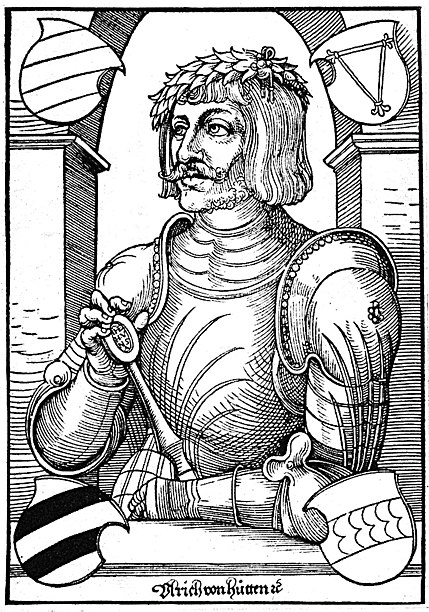
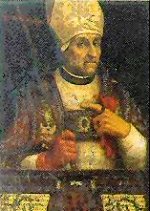



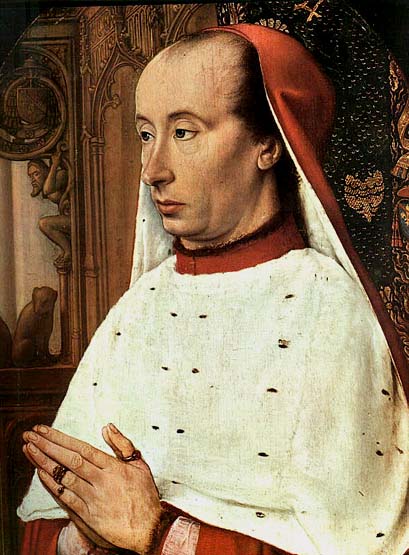





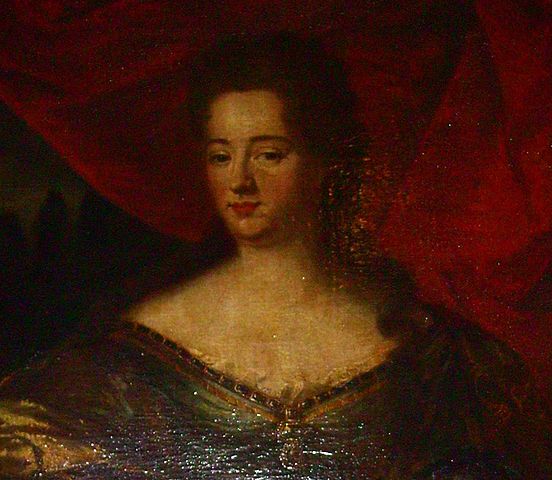

.jpg/200px-Louis_de_Bourbon(Couleurs).jpg)

No comments:
Post a Comment